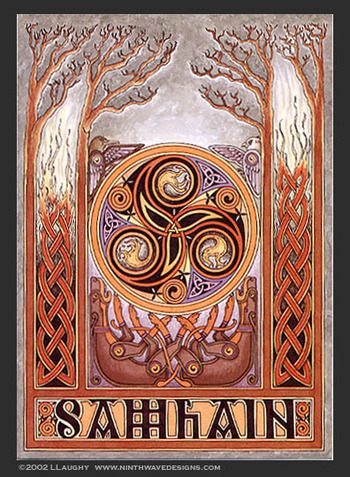| This Week’s Topic… | |

Best viewed in
|
Samhain
Samhain is the word for November in the Gaelic languages. The Scottish Gaelic spelling is Samhainn or Samhuinn (for the feast), or an t-Samhain (for the month). The Festival of Samhain is a celebration of the end of the harvest season in Gaelic culture, and is generally regarded as 'The Celtic New Year'. The same word was used for a month in the ancient Celtic calendar, in particular the first three nights of this month, with the festival marking the end of the summer season and the end of the harvest. A modernized version of this festival continues today in some of the traditions of the Catholic All Souls' Day, the secular Halloween, and in folk practices of Samhain itself in the Celtic Nations and the Irish and Scottish diasporas. It is also observed by various types of Neopagans. The Gaulish calendar appears to have divided the year into two halves: the 'dark' half, beginning with the month Samonios (the October/November lunation), and the 'light' half, beginning with the month Giamonios (the April/May lunation). The entire year may have been considered as beginning with the 'dark' half, so that the beginning of Samonios may be considered the Celtic New Year's day. The celebration of New Year itself may have taken place during the 'three nights of Samonios' (Gaulish trinux[tion] samo[nii]), the beginning of the lunar cycle which fell nearest to the midpoint between the autumnal equinox and the winter solstice. The lunations marking the middle of each half-year may also have been marked by specific festivals. The Coligny calendar marks the mid-summer moon, but omits the mid-winter one. The seasons are not oriented at the solar year, viz. solstice and equinox, so the mid-summer festival would fall considerably later than summer solstice, around 1 August (Lughnasadh). It appears that the calendar was designed to align the lunations with the agricultural cycle of vegetation, and that the exact astronomical position of the Sun at that time was considered less important. In medieval Ireland, Samhain became the principal festival, celebrated with a great assembly at the royal court in Tara, lasting for three days. After being ritually started on the Hill of Tlachtga, a bonfire was set alight on the Hill of Tara, which served as a beacon, signaling to people gathered atop hills all across Ireland to light their ritual bonfires. The custom has survived to some extent, and recent years have seen a resurgence in participation in the festival. The Samhain celebrations have survived in several guises as a festival dedicated to the harvest and the dead. In Ireland and Scotland, the Féile na Marbh, the 'festival of the dead' took place on Samhain. The night of Samhain, in Irish, Oíche Shamhna and Scots Gaelic, Oidhche Shamhna, is one of the principal festivals of the Celtic calendar, and falls on the 31st of October. It represents the final harvest. In modern Ireland and Scotland, the name by which Halloween is known in the Gaelic language is still Oíche/Oidhche Shamhna. It is still the custom in some areas to set a place for the dead at the Samhain feast, and to tell tales of the ancestors on that night. Divination is a common folkloric practice that has also survived in rural areas. The most common uses were to determine the identity of one's future spouse, the location of one's future home, and how many children a person might have. Seasonal foods such as apples and nuts were often employed in these rituals. Apples were peeled, the peel tossed over the shoulder, and its shape examined to see if it formed the first letter of the future spouse's name. Nuts were roasted on the hearth and their movements interpreted - if the nuts stayed together, so would the couple. Egg whites were dropped in a glass of water, and the shapes foretold the number of future children. Children would also chase crows and divine some of these things from how many birds appeared or the direction the birds flew. |
